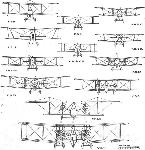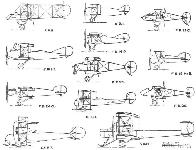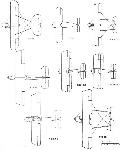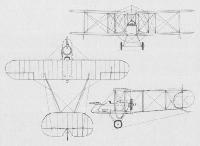В.Кондратьев Самолеты первой мировой войны
В декабре 1915 г. главный конструктор компании "Виккерс" Гарольд Бэрнуэлл доработал F.B.5, уменьшив размах крыльев и убрав противокапотажную лыжу. Одновременно была подвергнута модернизации стрелковая установка - вместо шкворня использовали турель. Новый самолет получил обозначение F.B.9 и строился на двух заводах компании "Виккерс" в метрополии и по лицензии на одном из французских предприятий. Этими аппаратами были вооружены пять эскадрилий из состава британского Экспедиционного корпуса во Франции и несколько эскадрилий французских ВВС. Во второй половине войны самолеты применялись в основном в учебных подразделениях, так как были устойчивы в воздухе и просты в управлении. Некоторые учебно-тренировочные самолеты имели двойное управление. Широко использовались F.B.9 в школах воздушных стрелков, где оснащались турелью Скарфа. На фронт было поставлено около 100 машин.
В 1915-1916 гг. самолеты F.B.5 и F.B.9, наряду с другими британскими летательными аппаратами с толкающим воздушным винтом - D.H.2, F.E.2B и F.E.8 - выдержали самые трудные для авиации Антанты бои. Особенно тяжелой стала битва на Сомме, где немцы имели значительное превосходство в воздухе.
ДВИГАТЕЛЬ
"Рон", 110л.с.
ВООРУЖЕНИЕ
1 подвижный 7,7-мм "Льюис" на шкворневой или турельной установке в передней кабине, несколько мелких бомб.
ЛЕТНО-ТЕХНИЧЕСКИЕ ХАРАКТЕРИСТИКИ (ВИККЕРС FB.9)
Размах, м 10,3
Длина, м 8,5
Площадь крыла, кв.м 31,6
Сухой вес, кг 467
Взлетный вес, кг 858
Двигатель: "Гном-Моносупап"
мощность, л. с. 100
Скорость максимальная, км/ч 133
Время набора высоты, м/мин 2000/19
Потолок, м 3350
Экипаж, чел. 2
C.Andrews Vickers Aircraft since 1908 (Putnam)
<...>
Last of the line to be made was the F.B.9, which was sufficiently sophisticated to be known as the Streamline Gunbus. A lot of cleaning up had had to be done, the wing tips and tailplane were neatly rounded off, the nacelle was of much better aerodynamic form and the older skid undercarriage (which incidentally had proved very useful on the early primitive landing grounds in France) was replaced by a V type. Streamlined, adjustable Rafwires (External bracing wires invented by the Royal Aircraft Factory. They were rolled, on specially designed machines, from round swaged steel rods to an oval streamline section to reduce drag) had replaced the stranded steel cables and turnbuckles of the earlier machines. Between June 1916 and September 1917, 95 F.B.9s were built and used mostly for training duties at home, as by then the much more powerful F.E.2d with a 250 hp Rolls-Royce Eagle I was available for overseas as a pusher fighter-bomber. One F.B.9 was especially modified as a trench-strafer with an armour-plated nacelle and an oleo undercarriage.
Some F.B.9s were used in the Battle of the Somme which started on 1 July, 1916. From the personal notebook of 2nd Lt Lionel Morris of No.l1 Squadron, RFC, it is learned that he and Lt Torre of the same squadron were detailed to collect 'Streamlined Gunbuses' from Villacoublay aerodrome near Paris on 25 June, 1916, as stand-ins for the Squadron's F.E.2bs fitted with the 160 hp Beardmore engine. This engine, which was a more powerful version of the 120 hp standard Beardmore, was giving continual trouble, leading to serious break-up of internal components, just at a time when every aeroplane was needed for the first major offensive of the Allies. It is probable therefore that French-built or French-assembled F.B.9s were used at that time by other RFC squadrons primarily equipped with the higher-powered Beardmore F.E.2bs.
In France, S. A. Darracq of Suresnes in fact made 99 F.B.5s and F.B.9s under licence, but an intention for Vickers' Italian subsidiary, Vickers-Terni, to manufacture the type fell through for political reasons. A further development, the F.B.10, was projected with the Italian 100 hp Isotta-Fraschini engine, but was not proceeded with, as Vickers designers were otherwise engaged in evolving the variety of experimental aircraft as described in the next chapter. In any case, the Gunbus was being outclassed by more advanced designs of fighting aeroplanes.
F.B.9
Accommodation: Pilot and gunner
Engine: 100 hp Gnome monosoupape
Span: 33 ft 9 in
Length: 28 ft 5 1/2 in
Height: 11 ft 6 in
Wing Area: 340 sq ft
Empty Weight: 1,029 lb
Gross Weight: 1,820 lb
Max Speed: 82.6 mph at sea level
Service Ceiling:11,000 ft
Climb to: 10,000 ft in min
Range: 250 miles
Armament: One Lewis
P.Lewis The British Fighter since 1912 (Putnam)
In December, 1915, a month after the debut of the twin-engine F.B.8, another two-seat Vickers fighter appeared. This time it was the single-engine F.B.9 - a revised F.B.5. Significant alterations in the design, bestowing an altogether more rounded appearance, were the replacement of the square tips of all horizontal flying surfaces by those of curved outline, and the shapelier nose to the nacelle. The comparatively complex form of twin-skid undercarriage was supplanted by a much neater V type. At the rear of the nacelle was fitted the 100 h.p. Monosoupape Gnome while, at the front, the gunner was given a new form of rotating circular gun-ring with a corresponding increase in the effectiveness of the weapon it supported. Although the top speed, compared with that of the F.B.5, had increased by 10 m.p.h., the F.B.9 appears to have been used mainly as a training type.
F.Mason The British Fighter since 1912 (Putnam)
Vickers E.F.B.6 and F.B.9
The efforts to extend the successful F.B.5 Gunbus formula, as has been shown, brought forth the twin-engine F.B.7 and F.B.8, which appeared too late to warrant further work on them. Another design, the Vickers E.F.B.6, was less radical in that it retained the basic F.B.5 single pusher engine format. It did however adopt the upper wing’s greatly increased span with large overhang that characterised Flanders’ F.B.7, in an effort to increase the F.B.5’s load-carrying ability. Like the F.B.7, however, this aeroplane was blighted by the plethora of struts and bracing wires necessary for this wing configuration, and its poor performance on only a single engine resulted in the aircraft’s further development being abandoned.
Instead efforts focussed on generally cleaning up the F.B.5 itself, and in December 1915 the prototype F.B.9 was first flown. This retained the 100hp Gnome monosoupape rotary but featured smaller wings with rounded tips; the landing skids were omitted and the nacelle nose was redesigned to appear as a D-shape in side elevation. Raf-wires replaced the former twisted-strand cables for interplane bracing; and the spigot mounting for the nose Lewis gun was replaced by a Vickers ring to permit the gun to traverse.
The nose profile underwent further improvement, the bottom line of the nacelle being lengthened to make possible an improved aerodynamic shape. Thus modified the F.B.9 possessed a maximum speed of 82.6 mph at sea level - an increase of about a dozen miles per hour over the F.B.5. At least one F.B.9 with the improved nose profile was powered by a 110hp Le Rhone engine.
Although Vickers had high hopes for this new Gunbus, and orders were placed for about 119 production aircraft, there is little doubt that from the outset the War Office was more interested in the F.B.9 as a trainer than as an operational gun carrier. That alone was ample testimony to its excellent handling qualities, but the truth was that the Gunbus was already being rendered obsolete by the arrival of the synchronized front gun. It is possible, though doubtful, that a few F.B.9s were sent to France, and it is unlikely that any were flown operationally. On the other hand, fifty were distributed among home-based training units, including No 6 Reserve Squadron at Catterick, and No 10 Reserve Squadron at Joyce Green.
The accompanying data refer to the production F.B.9.
Type: Single pusher engine, single-seat, two-bay biplane gun carrier.
Manufacturer: Vickers Ltd, Knightsbridge, London; aircraft built at Weybridge, Surrey.
Powerplant: One 100hp Gnome monosoupape engine driving two-blade pusher propeller (as standard); also 110hp Le Rhone engine.
Dimensions: Span, 33ft 9in; length, 28ft 5 1/2 in; height, 11ft 6in; wing area, 340 sq ft.
Weights: Tare, 1,029lb; all-up, 1,892lb.
Performance: Max speed, 82.6 mph at sea level; climb to 10,000ft, 51 min; endurance, 5 hr.
Armament: One 0.303in Lewis machine gun on Vickers or Scarff ring mounting on front cockpit.
Prototype and Production: One prototype (first flown in December 1915). Approximately 119 production aircraft (Nos 5271-5290,7812-7835, A1411-A1460 and A8601-A8625)
Summary of Service: No evidence has been traced to suggest that F.B.9s flew operationally. Fifty aircraft were distributed among such units as Nos 6 and 10 Reserve Squadrons, and No 187 Training Squadron in the United Kingdom.
W.Green, G.Swanborough The Complete Book of Fighters
VICKERS F.B.9 UK
Dubbed unofficially the Streamline Gunbus, the F.B.9, which emerged towards the end of 1915, introduced numerous refinements over its predecessor, the F.B.5. The fuselage nacelle was of improved aerodynamic form; the wings and tailplane sported rounded tips; streamlined Rafwires replaced stranded steel cables and turnbuckles for interplane bracing, and a plain, Vee-type undercarriage supplanted the twin skids previously used. The standard power plant remained the 100 hp Gnome Monosoupape rotary. Vickers built a total of 95 F.B.9s, and a further 20-30 were built by Darracq in France, some of which were issued to the RFC (No 11 Sqn) and were used during the Battle of the Somme which began on 1 July 1916. The manufacture of the F.B.9 in Italy by Vickers-Terni fell through owing to political reasons. A version designated F.B.10 powered by an Isotta-Fraschini engine was proposed but not built. Outclassed by more advanced fighting aeroplanes, the F.B.9s saw only brief first-line service, the great majority being assigned tuitional tasks on delivery to the RFC, for which some were retrofitted with dual controls. For gunnery training, some F.B.9s were fitted with a Scarff ring on the front cockpit, but none remained on charge at the time of the Armistice.
Max speed, 83 mph (134 km/h) at sea level, 75 mph (121 km/h) at 6,500 ft (1980 m).
Time to 6,500 ft (1 980 m), 19 min.
Service ceiling, 11,000 ft (3 355 m).
Endurance, 4.5 hrs.
Empty weight. 1,029 lb (467 kg).
Loaded weight. 1,892 lb (858 kg).
Span, 33 ft 9 in (10,29 m).
Length, 28 ft 5 1/2 in (8,67m).
Height, 11 ft 6 in (3.50 m).
Wing area, 340 sq ft (31.59 m2).
J.Bruce British Aeroplanes 1914-1918 (Putnam)
Vickers F.B.9
THE Vickers F.B.9, which first appeared in December, 1915, was an improved version of the F.B.5. It was similar to the F.B.5 in general appearance and in construction; but both mainplanes and tailplane had rounded tips, a plain vee undercarriage replaced the original twin-skid structure, and Rafwires replaced cables in the interplane bracing.
The nacelle was of rather neater appearance, and the gunner’s cockpit was fitted with an improved form of gun mounting which could be rotated and thereby enhanced the gun’s flexibility. The standard engine remained the 100 h.p. Gnome Monosoupape, and the various refinements gave the F.B.9 a maximum speed 10 m.p.h. higher than that of the F.B.5.
The shape of the nacelle underwent some changes. Originally the side elevation of the nose was D-shaped, but this was later replaced by a more pointed form which gave a long bottom line to the nacelle. At least one F.B.9 with the later nacelle had a 110 h.p. Le Rhone engine.
It seems rather doubtful whether the F.B.9 was used operationally. The only official reference to its use treats it as a type distinct and different from the F.B.5, and states that the F.B.9 was issued to training units only. Several of those used for training purposes were fitted with dual control, and others were given a Scarff ring-mounting on the front cockpit for training observers in aerial gunnery.
SPECIFICATION
Manufacturers: Vickers Ltd. (Aviation Department), Imperial Court, Basil Street, Knightsbridge, London, S.W.
Power: 100 h.p. Gnome Monosoupape; 110 h.p. Le Rhone.
Dimensions: Span: 33 ft 9 in. Length: 28 ft 5 1/2 in. Height: 11 ft 6 in. Chord: 5 ft 6 in. Gap: 6 ft. Stagger: nil. Dihedral: 1° 30'. Incidence: 3°. Span of tail: 14 ft 3 in. Wheel track: 5 ft 10 1/2 in. Airscrew diameter: 9 ft.
Areas: Wings: upper 177 sq ft, lower 163 sq ft, total 340 sq ft. Ailerons: each 14-25 sq ft, total 57 sq ft. Tailplane: 54 sq ft. Elevators: 24-6 sq ft. Fin: 8-5 sq ft. Rudder: 13-25 sq ft.
Weights and Performance (with Gnome engine): Weight empty: 1,029 lb. Military load: 63 lb. Crew: 360 lb. Fuel and oil: 440 lb. Loaded: 1,892 lb. Maximum speed at ground level: 82-6 m.p.h.; at 6,500 ft: 79 m.p.h.; at 10,000 ft: 75 m.p.h. Climb to 1,000 ft: 2 min 30 sec; to 2,000 ft: 5 min 20 sec; to 3,000 ft: 7 min 45 sec; to 4,000 ft: 10 min 30 sec; to 6,500 ft: 19 min; to 10,000 ft: 51 min. Service ceiling: 11,000 ft. Endurance: 5 hours.
Tankage: Petrol: 50 gallons. Oil: 8 gallons.
Armament: One Lewis machine-gun on Vickers ring-mounting or Scarff ring-mounting on forward cockpit.
Service Use: Training: No. 6 Reserve Squadron, Catterick; No. 10 Reserve Squadron, Joyce Green; No. 188 Squadron, formed at Retford, March, 1918.
Production and Allocation: Serial numbers were allotted for a total of ninety-five Vickers F.B.9s. A total of fifty were distributed to R.F.C. training units.
Serial Numbers: 5271-5290: built under Contract No. 87/A/341. A.1411-A.1460: built at Vickers’ Weybridge works, under Contract No. 87/A/485. A.8601-A.8625: built at Weybridge, under Contract No. 87/A/485.
Notes on Individual Machines: 5274 and 5275 were used by No. 6 Reserve Squadron. A.1412: No. 10 Reserve Squadron.
H.King Armament of British Aircraft (Putnam)
<...>
The aircraft described by C. F. Andrews as the F.B.5A had an armour-plated nose, generally of the form shown in the Vickers diagrams reproduced. This same aeroplane is illustrated in an official publication as an F.B.9, and a drawing in this same publication shows a Vickers-Challenger ring-mounting with the arms of the gun frame slightly bowed.
Jane's All The World Aircraft 1919
F.B.9. PUSHER BIPLANE.
Developed from the successful F.B.6 "Gun bus" that used a 100 hp Monosoupape Gnome engine and was employed as a fighter-scout from 1914-16. Pilot and gunner observer placed in tandem. Fitted with various rotary and fixed radial engines. Armament: Lewis gun on ring mounting-One of the best fighting machines of its time.
Model and date. 1914. Fighting type biplane.
Length feet (m.) 27 1/2 (8.23)
Span feet (m.) 37 (11.28)
Area sq. feet (m2) 385 (36)
Weight total, lbs (kgs.) 1760 (799)
useful, lbs (kgs.) 900 (408)
Motor h.p. 100 Monosoupape
Speed max. m.p.h. (km.) 70 (110)
min. m.p.h. (km.) 45 (70)
Endurance hrs 1 1/2 hours
Remarks, Notes and Details
Climbing capacity of 450 feet per minute fully loaded. Radius of action 300 miles, and carries (including pilot, passenger and gun,) 300 rounds of ammunition. Fuselage of high tensile steel.
This machine has been designed entirely for offensive action in the air against other aeroplanes. For this purpose the gun is mounted in the front of the machine where it has a clear field of fire. The firer has also a perfectly clear view, and is sheltered from all wind by the design of the cowl.
Журнал Flight
Flight, June 12, 1919.
"MILESTONES"
THE VICKERS MACHINES
The F.B. 9. (Dec, 1915)
In December, 1915, a modified "Gun-'bus" was produced. It was effectually the same machine as the F.B. 5, but fitted with minor improvements such as streamline wires, Vee undercarriage, and an improved gun mounting; the speed was also substantially increased. This machine was known as the F.B. 9.














